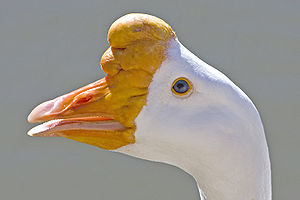Difference between revisions of "AY Honors/Poultry/Chinese Geese"
From Pathfinder Wiki
(initial submission) |
m (1 revision: re-import from WB, including edit history) |
||
| (2 intermediate revisions by one other user not shown) | |||
| Line 4: | Line 4: | ||
| description = The Chinese Goose is a domesticated version of the Swan Goose. Sexes are similar, although the male is larger. The voice is a loud honking. It grazes on sedges, and rarely swims. It forms small flocks outside the breeding season. Some domesticated, introduced, or feral populations may be completely white. Some variations have a "bump" or "knob" at the top of the beak, which is more prominent on males than females. By 6–8 weeks of age, the knob is already pronounced enough that it can be used for sexing. A female goose usually lays 50–60 eggs over the course of the breeding season (February through June), although there are reports of Chinese geese laying up to 100 eggs during that time. | | description = The Chinese Goose is a domesticated version of the Swan Goose. Sexes are similar, although the male is larger. The voice is a loud honking. It grazes on sedges, and rarely swims. It forms small flocks outside the breeding season. Some domesticated, introduced, or feral populations may be completely white. Some variations have a "bump" or "knob" at the top of the beak, which is more prominent on males than females. By 6–8 weeks of age, the knob is already pronounced enough that it can be used for sexing. A female goose usually lays 50–60 eggs over the course of the breeding season (February through June), although there are reports of Chinese geese laying up to 100 eggs during that time. | ||
}} | }} | ||
| + | |||
| + | [[Category:Adventist Youth Honors Answer Book|{{SUBPAGENAME}}]] | ||
Revision as of 18:40, 5 July 2012
Chinese Goose
The Chinese Goose is a domesticated version of the Swan Goose. Sexes are similar, although the male is larger. The voice is a loud honking. It grazes on sedges, and rarely swims. It forms small flocks outside the breeding season. Some domesticated, introduced, or feral populations may be completely white. Some variations have a "bump" or "knob" at the top of the beak, which is more prominent on males than females. By 6–8 weeks of age, the knob is already pronounced enough that it can be used for sexing. A female goose usually lays 50–60 eggs over the course of the breeding season (February through June), although there are reports of Chinese geese laying up to 100 eggs during that time.

